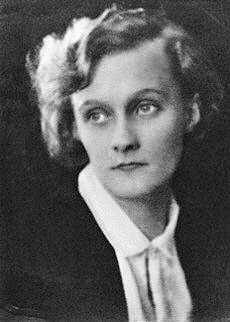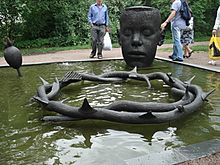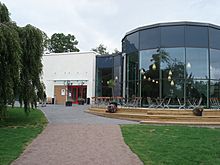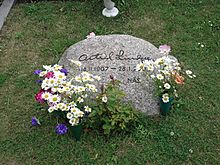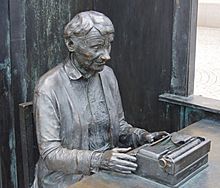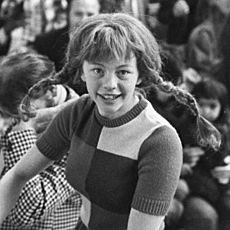Astrid Lindgren facts for kids
Quick facts for kids
Astrid Anna Emilia Lindgren
|
|
|---|---|

Lindgren c. 1960
|
|
| Born | Astrid Anna Emilia Lindgren 14 November 1907 Vimmerby, Kalmar, Sweden |
| Died | January 28, 2002 (aged 94) Stockholm, Sweden |
| Resting place | Vimmerby, Kalmar |
| Occupation | Writer |
| Period | 1904-2002 |
| Genre |
|
| Notable awards |
|
|
|
|
| Signature | |
Astrid Anna Emilia Lindgren ( née Ericsson; 14 November 1907 – 28 January 2002) was a Swedish writer of fiction and screenplays. She is best known for several children's book series, featuring Pippi Longstocking, Emil of Lönneberga, Karlsson-on-the-Roof, and the Six Bullerby Children (Children of Noisy Village in the US), and for the children's fantasy novels Mio, My Son, Ronia the Robber's Daughter, and The Brothers Lionheart. Lindgren worked on the Children's Literature Editorial Board at the Rabén & Sjögren publishing house in Stockholm and wrote more than 30 books for children.
In 2017, she was calculated to be the world's 18th most translated author. Lindgren had by 2010 sold roughly 167 million books worldwide. In 1994, she was awarded the Right Livelihood Award for "her unique authorship dedicated to the rights of children and respect for their individuality." Her opposition to corporal punishment of children resulted in the world's first law on the matter in 1979, while her campaigning for animal welfare led to a new law, Lex Lindgren, in time for her 80th birthday.
Contents
Biography
Astrid Lindgren was born on 14 November 1907. She grew up in Näs, near Vimmerby, Småland, Sweden. She was the daughter of Samuel August Ericsson and Hanna Jonsson . Lindgren had two sisters, Stina and Ingegerd, and a brother, Gunnar Ericsson, who became a member of the Swedish parliament.
Upon finishing school, Lindgren took a job with the local newspaper, Vimmerby Tidning, in Vimmerby. When she became pregnant with the chief editor's child in 1926, he proposed marriage. She did not accept, and moved to Stockholm, learning to become a typist and stenographer. There she gave birth to her son Lars in Copenhagen and left him with another family to care for him.
Although poorly paid, she saved whatever she could and travelled as often as possible to Copenhagen to be with Lars; often just over a weekend, spending most of her time on the train back and forth. Eventually, she managed to bring Lars home, leaving him in the care of her parents until she could afford to raise him in Stockholm. In 1931 she married her boss, Sture Lindgren (1898-1952). Three years later, in 1934, Lindgren gave birth to her second child, Karin, who later became a translator.
The character Pippi Longstocking was invented for her daughter Karin to amuse her while she was ill in bed. Lindgren later related that Karin had suddenly said to her, "Tell me a story about Pippi Longstocking," and the tale was created in response to that request.
The family moved in 1941 to an apartment on Dalagatan, with a view over Vasaparken, where Astrid lived until her death.
Lindgren died in her home in central Stockholm on 28 January 2002 at the age of 94. Her funeral took place in the Storkyrkan in Gamla stan. Among those attending were King Carl XVI Gustaf with Queen Silvia and others of the royal family, and Prime Minister Göran Persson. The ceremony was described in Dagens Nyheter as "the closest you can get to a state funeral."
Career
As the children were sitting there eating pears, a girl came walking along the road from town. When she saw the children she stopped and asked, "Have you seen my papa go by?"
"M-m-m," said Pippi. "How did he look? Did he have blue eyes?"
"Yes," said the girl.
"Medium large, not too tall and not too short?"
"Yes," said the girl.
"Black hat and black shoes?"
"Yes, exactly," said the girl eagerly.
"No, that one we haven't seen," said Pippi decidedly.
Lindgren worked as a journalist and secretary before becoming a full-time author. In the early 1940s, she worked as a secretary for criminalist Harry Söderman; the Norsk biografisk leksikon cites this experience as an inspiration for her fictional detective Bill Bergson.
In 1944, Lindgren won second prize in a competition held by the book publishing company Rabén & Sjögren, with the novel Britt-Marie lättar sitt hjärta (The Confidences of Britt-Marie). In 1945 she won first prize in the same competition with the chapter book Pippi Långstrump (Pippi Longstocking), which had been rejected by the book publishing company Bonniers. (Rabén & Sjögren published it with illustrations by Ingrid Vang Nyman, the latter's debut in Sweden.) Since then it has become one of the most beloved children's books in the world and has been translated into at least 100 languages. While Lindgren almost immediately became a much appreciated writer, the irreverent attitude towards adult authority that distinguishes many of her characters has occasionally drawn the ire of conservatives.
She wrote what became the 1950 book Kati in America as a series of short pieces for the Swedish women's magazine Damernas Värld. In 1956, the inaugural year of the Deutscher Jugendliteraturpreis, the German-language edition of Mio, min Mio (Mio, My Son) won the Children's book award.
In 1958, Lindgren received the second Hans Christian Andersen Medal for Rasmus på luffen (Rasmus and the Vagabond), a 1956 novel developed from her screenplay and filmed in 1955. The biennial International Board on Books for Young People, now considered the highest lifetime recognition available to creators of children's books, soon came to be called the Little Nobel Prize. In her career she wrote more than 30 books for children. In 2017, she was calculated to be the world's 18th most translated author. By 2010, she had sold roughly 167 million books worldwide.
Politics
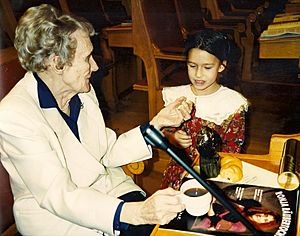
In 1978, when she received the Peace Prize of the German Book Trade, Lindgren spoke against corporal punishment of children in a speech entitled Never Violence!. After that she teamed up with scientists, journalists and politicians to promote non-violent upbringing. In 1979, a law was introduced in Sweden prohibiting violence against children in response to her demands. Until then there was no such law anywhere in the world.
From 1985 to 1989, Lindgren, with the veterinarian Kristina Forslund, wrote articles concerning animal protection and mass production in the Swedish newspapers Expressen and Dagens Nyheter. They wanted to launch an awareness campaign to promote better animal treatment in factory farming. Eventually their activities led to a new law which was called Lex Lindgren and was presented to Lindgren on her 80th birthday. During that time it was the strictest law concerning animal welfare in the world. However, Lindgren and Forslund were unsatisfied with it. Not enough had been done and only minor changes occurred. The articles Forslund and Lindgren wrote were later published in the book Min ko vill ha roligt (My cow wants to have fun).
Lindgren was well known both for her support for children's and animal rights and for her opposition to corporal punishment and the EU. In 1994, she received the Right Livelihood Award, "For her commitment to justice, non-violence and understanding of minorities as well as her love and caring for nature." She was a member of the freedom of speech-promoting, anti-imperialist organization Folket i Bild/Kulturfront.
Honors and memorials
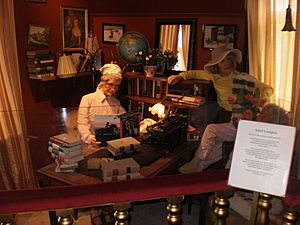
In 1967, the publisher Rabén & Sjögren established an annual literary prize, the Astrid Lindgren Prize, to mark her 60th birthday. The prize—40,000 Swedish kronor—is awarded to a Swedish-language children's writer every year on Lindgren's birthday in November. In 1995, she was awarded the Illis quorum gold medal by the Swedish government. On her 90th birthday, she was pronounced International Swede of the Year 1997. In its entry on Scandinavian fantasy, The Encyclopedia of Fantasy named Lindgren the foremost Swedish contributor to modern children's fantasy. Its entry on Lindgren stated that "Her niche in children's fantasy remains both secure and exalted. Her stories and images can never be forgotten."
Following Lindgren's death, the government of Sweden instituted the Astrid Lindgren Memorial Award in her memory. The award is the world's largest monetary award for children's and youth literature, in the amount of five million Swedish kronor. The collection of Lindgren's original manuscripts in the Royal Library in Stockholm was placed on UNESCO's Memory of the World Register in 2005. On 6 April 2011, Sweden's central bank Sveriges Riksbank announced that Lindgren's portrait would feature on the 20 kronor banknote, beginning in 2014–2015. The banknote had before that featured the Swedish author Selma Lagerlöf. In 2018, Pernille Fischer Christensen directed the film Becoming Astrid (Swedish: Unga Astrid), a biographical drama about Lindgren's early life.
Asteroid Lindgren
Asteroid 3204 Lindgren, discovered in 1978 by Soviet astronomer Nikolai Chernykh, was named after her. The name of the Swedish microsatellite Astrid 1, launched on 24 January 1995, was originally selected only as a common Swedish female name, but within a short time it was decided to name the payload instruments after characters in Lindgren's books: PIPPI (Prelude in Planetary Particle Imaging), EMIL (Electron Measurements – In-situ and Lightweight), and MIO (Miniature Imaging Optics).
Astrid's Wellspring
In memory of Lindgren, a memorial sculpture was created next to her childhood home, named Källa Astrid ("Astrid's Wellspring" in English). It is situated at the spot where Lindgren first heard fairy tales. The sculpture consists of an artistic representation of a young person's head (1.37 m high), flattened on top, in the corner of a square pond, and, just above the water, a ring of rosehip thorn.
Lindgren's childhood home is near the statue and open to the public. Just 100 metres (330 ft) from Astrid's Wellspring is a museum in her memory. The author is buried in Vimmerby, the Astrid Lindgren's World theme park is located. The children's museum Junibacken, in Stockholm, was opened in June 1996 with the main theme of the permanent exhibition being devoted to Lindgren; at the heart of the museum is a theme train ride through the world of Lindgren's novels.
Works
Translations
By 2012, Lindgren's books had been translated into 95 different languages or variants. The first chapter of Ronja the Robber's Daughter has in addition been translated into Latin. By 1997, some 3,000 editions of her books had been issued internationally. By the time of her death, her books had sold a total of 80 million copies. By 2010 that had risen to around 167 million books worldwide.
Filmography
The adaptation of Lindgren's books for film started with Rolf Husberg's 1947 Bill Bergson, Master Detective. This was followed in 1949 by Per Gunvall's adaptation of Pippi Longstocking, and then by many others.
Books
Some of her books include:
- The Pippi Longstocking series (Pippi Långstrump)
- The Six Bullerby Children (Barnen i Bullerbyn)
- Mio, my Mio (also known as Mio, my Son) (Mio, min Mio)
- Karlsson-on-the-Roof
- Madicken
- Emil of Lönneberga
- The Brothers Lionheart (Bröderna Lejonhjärta)
- Ronia the Robber's Daughter (Ronja rövardotter)
See also
 In Spanish: Astrid Lindgren para niños
In Spanish: Astrid Lindgren para niños
- List of Swedish language writers


